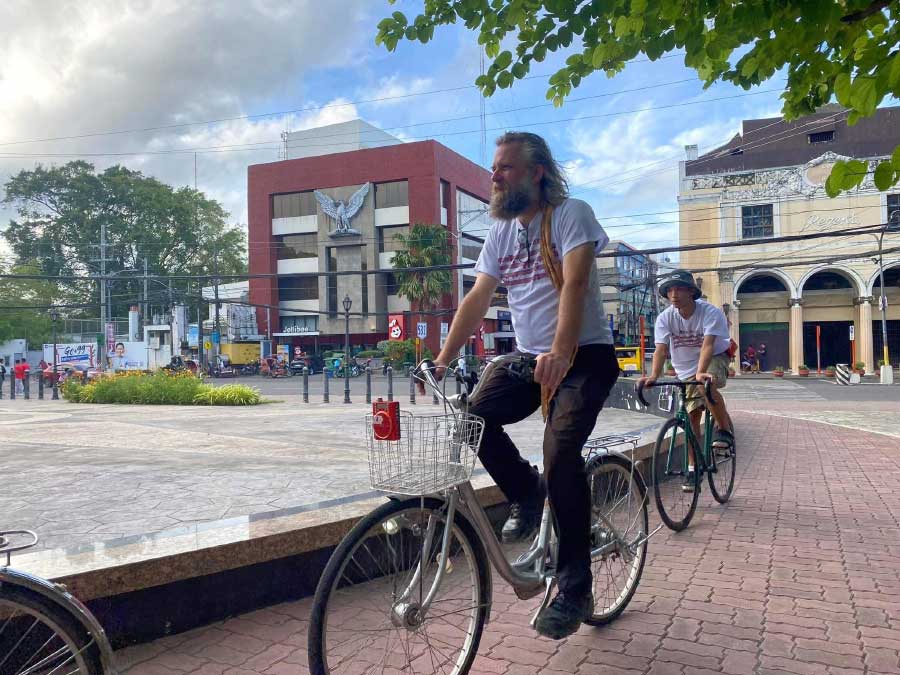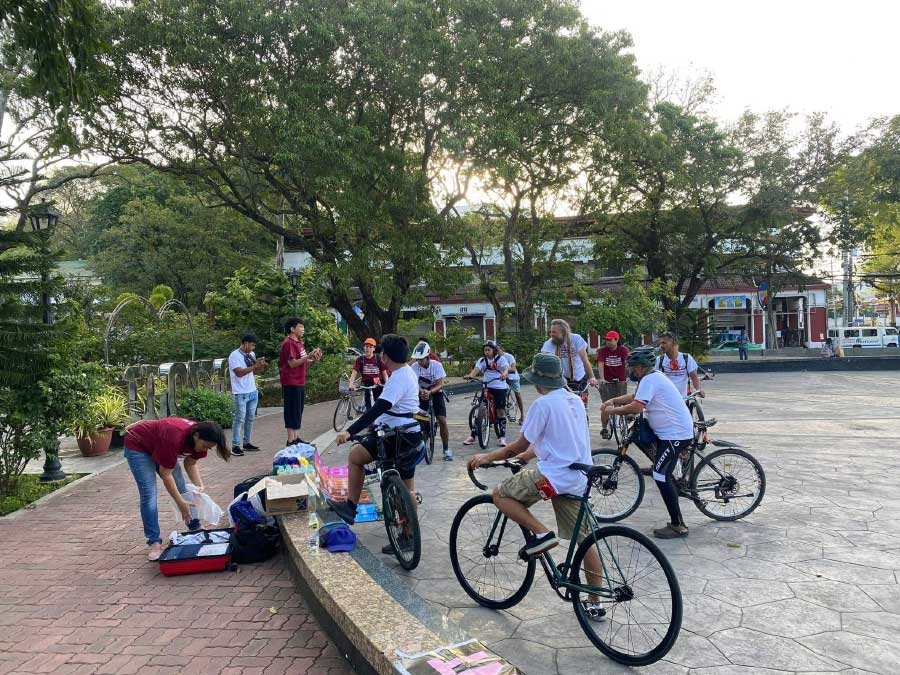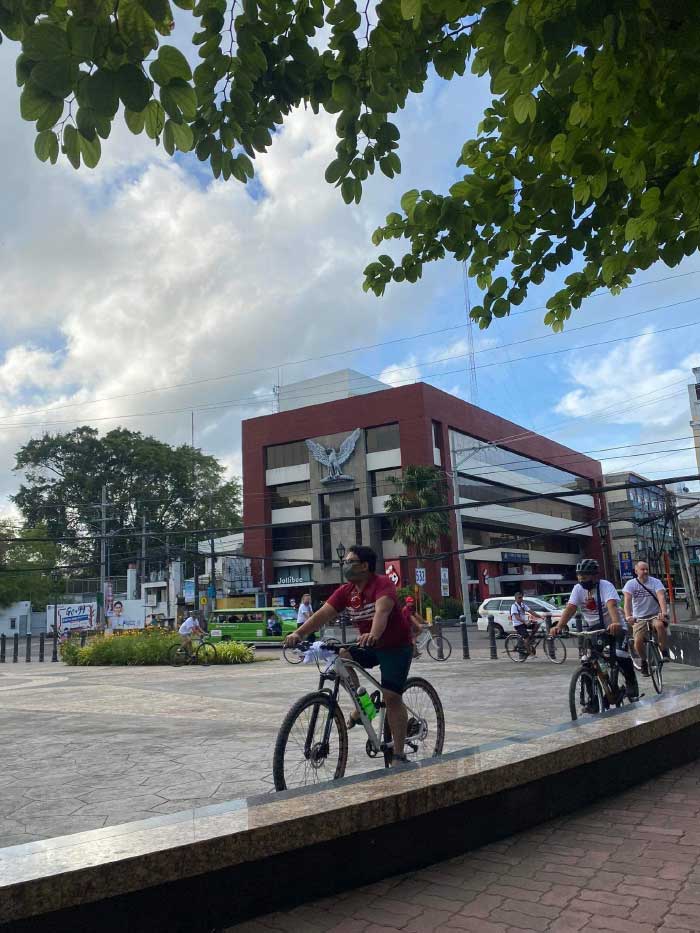By Joseph B.A. Marzan
A small gathering of cycling advocates and enthusiasts in Iloilo City’s Sunburst Park on Friday kick-started a 2-day project which hopes to highlight the social benefits of cycling as well as music as a form of art.
The ‘Music for 1000 Bicycles’ project returned to Iloilo City for the second time this year, the first being last January, attracting a minute number of bikers from the city and province.
The bikers followed the coordinated movements based on a pre-recorded musical track, biking along the park’s center like synchronized swimmers in a pool.
Associate Professor Dayang Yraola of the University of the Philippines-College of Fine Arts in Diliman, Quezon City, the project’s chief proponent, said that her vision of the performance is similar to that of a marching band.
“In a marching band, you hold instruments, you move from end to end. Here, instead of walking, you’re on a bike, and instead of the instruments, your music comes from an audio file on the player,” Yraola told Daily Guardian.
The project has three “levels”, including composition of music, choreographed performances through the bike rides, and a documentary featuring all of the rides under the project, including those made in Iloilo City.
The composed music was made with sounds from the environment, put on the application Soundscape, which put together, makes the musical piece named after the project itself. The composers came from the Philippines, Germany, Japan, and the United States.
It was started in July 2021 by Yraola, together with other relevant members of the academe, and is slated to end in February of next year.
Funding for the project came from the University of the Philippines,
The first ride was at UP Diliman, expanding to other places within and outside of the country including Baguio City, as well as Hamburg, Germany, Tokyo, Japan, and San Francisco, California.
She said that the idea was borrowed from Filipino composer and National Artist for Music Jose Maceda, whose archived collection was kept at the UP Center for Ethnomusicology where she worked as archivist and collections manager for 7 years.
One of Maceda’s ideas was a project called ‘Music for 1000 Automobiles’, where 1000 automobiles would open a particular radio channel while roving a freeway. This became the basis for the project.
Yraola said that their intention is to bring bikers and their two-wheeled friends together even in just smaller groups.
“The intention is not to have a performance with 1000 [bicycles] altogether. The intention is to build a community, piece by piece. Sometimes, we have rides as small as 12 people,” she explained.
“Whatever we finish at the end of February [2023], let’s say 420, the remaining number of bikes to complete a 1000 [bicycle collective] will have the scores available so that other people can use it,” she added.
She said that while the project promotes both music as an art and cycling culture, previous rides have revealed another aim that they have taken up—forging a new community combining both elements, which she called a gift.
She cited comments from bikers in the Diliman legs as well as one incident where a biker’s bike broke down, and a fellow biker, who was a stranger, helped them out.
“Biker communities have their own culture and communication, and musicians have that also, but you try to put that together, you create another community. It’s a good feeling when we go to the performance rides, we make new friends and it feels safe,” she said.
“There was one ride with more than 50 people. There was this girl who was a new cyclist, and she was being helped by someone from the Firefly Brigade, even though they just met. [Music for 1000 Bicycles] forges a brand-new community. I didn’t think about it when I was doing the project, but I just saw it happen there,” she added.
Citing her expertise in sound art, the professor says that the performances are very easy to follow, given that these are on bikes and briefly explaining that the movement will be easily and naturally felt by the body.
“The choreography is based on rhythm, on how the performers felt the rhythm. They will see that. I will [give instructions] and then eventually, their rhythm, pacing, and speed, the movement of their handlebars, eventually they will sync with the music they are listening to,” she explained.
“Previous experience isn’t needed here, but having feeling. The piece will only be a problem if the person is numb. But even if one is tone-deaf, they can feel sound and vibration in their body, naturally it will sync because of the world’s natural rhythm. You have to be patient more than excellent,” she said.
As to the cycling element, she said that it also adds to the concept of mobility, where bikes make their riders feel free to move, even just during their performance.
She cited her experience living in Hong Kong, where people in wheelchairs and crutches, as well as other mobility-challenged persons, were able to move owing to the infrastructure there.
“With your bike, even if it’s just as a performance, you could feel free to move, free to experience the air, because when you’re in Manila, if you don’t have a car or you don’t know how to commute, it would be difficult to move. But with your bike, you wouldn’t feel stopped by your inability to mobility,” she stated.
She also critiqued Iloilo City’s bike culture, expressing the lack of cycling infrastructure in areas where tourism isn’t heavy.
“I’ve tried biking here, and there were spaces that had bike lanes, but when we got to the market, I felt like we were calling for all saints. It didn’t belong to the touristy parts of the city, so the sense of security [as a cyclist] to move,” Yraola said.
Yraola hopes that after the project wraps up, there would be other similar stories of connection between bikers.
“When you see acts like this, you would have that new hope to say that humans aren’t so bad after all. This project has had small gifts. I hope after I give this project away, I hope other future organizers would have the same kind of experience,” she stated.
“If they want to add dances or even costumes, to add local sound, it’s their call. When you give classical music to somebody else, it changes as well. At the end of the day, Music for 1000 Bicycles is about humans who are willing to connect with other humans through cycling and music at the same time,” she added.
Prof. Early Sol Gadong, the local coordinator of the project in Iloilo, said that there should’ve been more local support, citing the “bike capital” and “art capital” titles that the city government baptizes over the city.
“For a place that calls itself a ‘bike capital’, you’d hope for more support. We may have not coordinated it well, we may have had fault there, but hopefully the local government and the [local] biking community would see that there is more to biking than fun rides, long rides, criterium races,” Gadong said.
“The city should really capitalize on activities that are more centered towards promoting the many spaces and landmarks here in Iloilo [City], more for bike commuters like us. Hopefully we’ll see more participants
Gadong also said that they would push to continue the project in the city after February using Yraola’s music.
The last ride prior to the closing of the project and the production of the documentary is expected to be held in Baguio City next year.
























